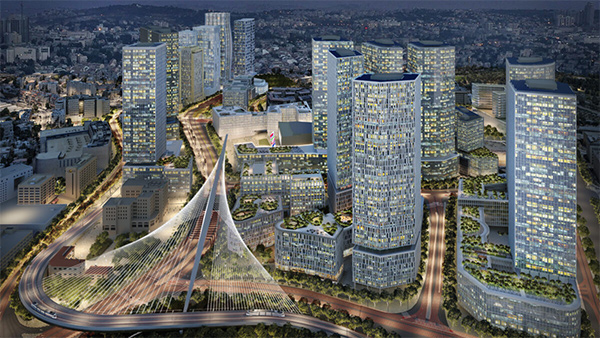A new construction project at the entrance to the holy city will change the face of Jerusalem, Mayor Moshe Leon tells Jewish Insider in an interview.
Jerusalem, with its deeply spiritual holy sites and ancient Old City, is preparing for a modernizing makeover with a series of massive infrastructure projects that are set to dramatically change the look and feel of Israel’s capital.
The largest of these construction projects is one that aims to put Jerusalem on the map as both a cultural and high-tech hub. Named Jerusalem Gateway, the new district is located at the entrance to the modern section of the city, starting at the iconic Chords Bridge and circling the Central Bus Station and the Yitzhak Navon Train Station. It will include multiple new streets, pathways, gardens and high-rise towers whose glassy facades may no longer justify the city’s legendary moniker: Jerusalem of Gold.
However, those behind the project, which includes the municipality of Jerusalem and the national government, are hoping it will breathe new life into the city, which in recent years has faced accusations of being neglected and abandoned. It is also hoped that the new quarter will ultimately attract large multinational companies, become a venue for massive international conventions and draw hundreds of thousands of new residents.
“Jerusalem is going through a revolution, not only at the entrance to the city but all across the city,” Jerusalem’s Mayor Moshe Leon told Jewish Insider in an interview. “My vision is that Jerusalem becomes a strong city economically and that attracts hundreds of thousands of new residents.”
The process, said Leon, who is up for reelection in October, is already underway with planning and construction at various stages to create thousands of new housing units, places of employment and leisure opportunities. Most significant of these, he said, is the massive construction project to revamp and modernize the entrance to Jerusalem.
Plans for the Jerusalem Gateway district were initially laid in 2014, with building work beginning one year later. Deemed a national infrastructure priority, the project, which stretches from the Chords Bridge to the edge of the Mahane Yehuda market and around to Sacher Park, the Knesset and other government offices, has received hefty financial backing from the government and will include several governmental offices. In addition, a large number of the new buildings, as well as an expansive new commercial center, are being bankrolled by private investors.
According to materials obtained by JI, the area is slated to become Israel’s largest transportation hub, with the already existing Central Bus Station offering bus routes countrywide and the Yitzhak Navon station, which opened in 2018, offering high-speed rail links to Modiin, Ben Gurion International Airport, Tel Aviv and beyond.
In addition, the new quarter will serve as the intersection for three proposed light rail lines that will span the city. The red line, which has been running for several years, is to be extended to reach the western edge of Jerusalem by the end of this year, while new yellow and green lines, which will reach other corners of Jerusalem, will become operational within the next two to four years.
Also promised in the new neighborhood are nearly two miles of bike lanes and a myriad of pedestrian walkways and public gardens that will weave between the new buildings, as well as 2,000-plus parking spaces. Within the next month, a new road and tunnel running under the quarter are set to open, in a bid to ease the constant traffic block at the city’s entrance.
As well as the transportation advances, the new project, which will be completed in phases over the next five years, will create “a new era of economic development for Jerusalem,” explained Deputy Mayor Fleur Hassan-Nahoum, who is responsible for foreign affairs and economic development in the city.
“As the city works hard to develop its innovation ecosystem, this project will serve as a high-tech, banking and professional hub for companies choosing the capital as its base and providing employment for a new generation of Jerusalemites,” she said.
Detailed plans of the new district show that there will be some 20 high-rise towers reaching to between 30 and 40 floors. Interspersed among those are several low-rise structures, parks and a large shopping mall. The mall, which builders say will be spacious and modern, will contrast with the more ancient look and cobblestone streets of Mamilla, a commercial street that opened a decade ago adjacent to the Old City.

Overall, Jerusalem Gateway, which is being developed by Jerusalem economic development company, Eden, will set aside 100,000 square meters for new residential units, and 25,000 meters for sheltered housing. There will be some 2,000 new hotel rooms, and it is hoped that the new area will create around 60,000 jobs. All of the construction is being built with LEED certification, say the project managers, meeting global environmental standards and making it attractive to international investors.
At the very center of the project is Jerusalem’s historic International Convention Center, better known in Israel as Binyanei HaUma. Built in the 1950s as the official home of the Zionist Congress, the building hosted the organization’s first conference in the nascent country. Under the Gateway Project, the ICC will receive a significant expansion and its outdated facilities will be upgraded, say those behind the project, turning it into one of the Middle East’s largest convention centers.
Among the high-rise towers set for construction, at least one will be dedicated to Jerusalem’s legal sector and several others will house what is hoped will become the city’s high-tech sector. The cornerstone for the new judicial building, which will bring under one roof the various local and district courthouses and legal offices that until now were spread across the city, was laid in a special ceremony this week. The other buildings, which are required to use only 30% Jerusalem stone in their façades, are in various stages of construction.
Source: The Jewish Insider